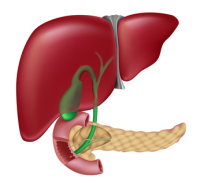Liver and Pancreas
 The human body is an amazing structure with all the various parts working together. Two of these important organs are the liver and the pancreas.
The human body is an amazing structure with all the various parts working together. Two of these important organs are the liver and the pancreas.
The Liver
Located in the right upper quadrant of the abdomen, the liver weighs about 1.5kg. Dark red in color, the liver is composed of lobules which in turn are made up of liver cells (hepatocytes), tiny branches of the hepatic artery and vein, and bile ducts. Blood filled with nutrients arrives from the intestine via the hepatic portal system and then goes on to filter though the lobules.
While most of the liver's functions involve the process of metabolism, this organ also creates the yellowish-brown or green colored fluid known as bile. The liver breaks down, stores and circulates vital substances and aids in constructing complex molecules such as enzymes.
Other liver functions include:
- Nutrient processing - The liver converts sugars into glycogen and produces amino acids.
- Glucose regulation - Maintaining the level of glucose in the blood is another liver function.
- Detoxification - The liver removes from the blood substances which are harmful, such as alcohol.
- Protein synthesis - This organ produces blood-clotting proteins and proteins for blood plasma.
- Mineral and vitamin storage - The liver stores copper, iron and the fat-soluble vitamins.
- Blood waste disposal - Eliminating bacteria and foreign particles is another task of the liver.
- Recycling blood cells - The liver breaks down red blood cells and reuses their constituents.
Bile is continuously manufactured in the liver and travels down to the gallbladder through the hepatic duct and cystic duct. The gallbladder, which is a pear-shaped sac under the liver, collects and stores the bile. Bile is forced out to the duodenum through the common bile duct and pancreatic duct, where the bile mixes with pancreatic juice.
Bile emulsifies fat in the duodenum, allowing enzymes from the pancreas to digest the fat. Fat ingestion is an important task of the bile. Without bile fat, particles from the food would remain undigested in the body.
As noted above, the liver also maintains the amount of blood sugars (or glucose) by removing excess sugars which are in the bloodstream and storing them in the form of starch in the cells of the liver. When the body has very low blood sugars in the bloodstream (a very dangerous condition), the starch is converted back to glucose by the liver.
The liver also converts proteins and fats in the body into glucose and uses these substances when needed. The liver is also responsible for producing important blood proteins which are essential for blood clotting. The liver produces bilirubin through the destruction of old erythrocytes. Poisonous materials are removed from the blood by the liver in a process called detoxification.
One other necessary function of the liver is the formation of urea. Amino acids are received in the liver from the blood; the liver removes ammonia, which is converted into urea, and the urea is removed by the kidneys and excreted with urine.
The liver also plays a role in controlling body temperature. The liver stores hematrin, which is necessary for the formation of RBCs, which are formed in fetal life. The liver serves as a storehouse for many enzymes, chemicals and vitamins.
The Pancreas
Located in the abdomen, the pancreas also plays an essential role in turning the food which is ingested into fuel for all of the body's cells. The pancreas is behind the stomach and is surrounded by other important organs, including the liver, spleen and small intestine. The pancreas is shaped like a flat pear and is about six inches long.
The wide part is called the head of the pancreas and it is positioned toward the middle of the abdomen. The middle section of the pancreas is called the neck and body. The thin end of the pancreas is called the tail and is off to the left side. There are several major blood vessels surrounding the pancreas, including the superior mesenteric artery, the superior mesenteric vein, the portal vein and the celiac axis, which supply blood to the pancreas as well as the other abdominal organs.
The pancreas is actually a gland which functions as both an exocrine and endocrine organ. As an exocrine, the pancreas produces juices filled with enzymes called amylase and lipase which aid in digesting food. These juices pass into the duodenum through the pancreatic duct.
As an endocrine gland, the pancreas secretes insulin into the bloodstream. Insulin is a hormone which is essential in releasing sugar from the blood, bringing glucose in the body's cells to be used for energy.
Pancreatic juices have a high concentration of bicarbonate ions containing digestive enzymes which act on lipids, proteins, and carbohydrates. Pancreatic amylase breaks down starch and other complex carbohydrates to turn them into more simple sugars. Protein-splitting enzymes from the pancreas include trypsin, which in turn break the proteins into shorter chains of amino acids called peptides.
The secretion of pancreatic juices for digestion is regulated by the nervous system and by the body's hormones. Parasympathetic impulses from the nervous system stimulate the section of gastric juices, with some of the impulses going to the pancreas to stimulate the secretion of pancreatic juice.
The hormone secretin is produced by the mucosa when acid chyme enters the duodenum, which travels in the blood to the pancreas. Secretin then stimulates the pancreas to produce a fluid with a high concentration of bicarbonate ions which neutralize the acids in the duodenum.
Posted in Liver & Pancreas
Ask a Question Or Join a Discussion


